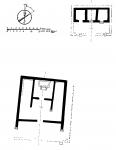Summary (English)
The continuation of excavations in Temple L led to better definition of its shape, size, construction phases and functions. The building occupied an almost square space of c.14.30 × 15.40 m (52 × 56 Oscan feet). The supporting structures were on the whole recognisable, but it remains to be ascertained whether between the front antae there were timber columns or pillars.
At about one metre back from the antae was the temple facade formed by a wall with a central door leading into a quadrangular interior space. At its centre was the cella, also closed by a wall with a door on the same axis as the first. The closure of the pronaos, the_ arca_ abutting the back wall of the cella and the trapeza (altar) with magistrate’s dedication placed in front of it indicates that the cult building also functioned as an aerarium.
Three hundred and forty-two coins, including 140 silver examples, were recovered from inside the arca, the latest dating to 207 B.C. during the course of the second Punic War.
Most of the coins were part of a large supply of money that came from Rome to finance the war against the Carthaginians.The excavation of the Ionic temple had already shown that in this period raiding by Hannibal’s army badly damaged the sanctuary. The sacking of Temple L can be attributed to one of these raids, if not the same one that led to the destruction of the Ionic temple.
However, the temple was not destroyed, given that during the 2nd century B.C. it was embellished and maintenance work was carried out, although no structural rebuilding tool place: the interventions involved the floors, the application of red, black and white plaster with mouldings, and the substitution of the roof with tiles that were destined for other buildings, including Temple B, as attested by the tile stamps.Temple L remained in use until the Social War, although it is not known with what function. It was not destroyed during this conflict but at the end of the war was closed and not used again. There are no traces of destruction at Pietrabbondante attributable to the Social War: the sanctuary was respected, although deprived of its public cult function. The building’s end can be attributed to a lack of maintenance during the 1st century B.C. with the consequent collapse of the roof, while the trapeza placed inside it by the Samnite magistrate in the 3rd century B.C. was still in situ.
The temple, certainly the earliest among those found to date at Pietrabbondante, was in use for at least three hundred years, between the 4th century and the beginning of the 1st century B.C.The remains of a small rectangular building of unknown function, dating to the 2nd century B.C., were excavated c. 15 m north of the temple. It had a low platform 12.70 × 8.50 m with three rooms measuring 2.90 × 3.50 m opening onto a portico with four columns.
- Adriano La Regina – Istituto Nazionale di Archeologia e Storia dell’Arte.
Director
Team
- Anna Dionisio
- Daniela Fardella
- Palma D'Amico
- Benito Di Marco
- Roberto Di Re
- Adriano La Regina - Istituto Nazionale di Archeologia e Storia dell'Arte
Research Body
- Istituto Nazionale di Archeologia e Storia dell'Arte
Funding Body
- Comune di Pietrabbondante
- Regione Molise






![Download [PDF]](/excavation/skins/fasti/images/results/download_sml.png)